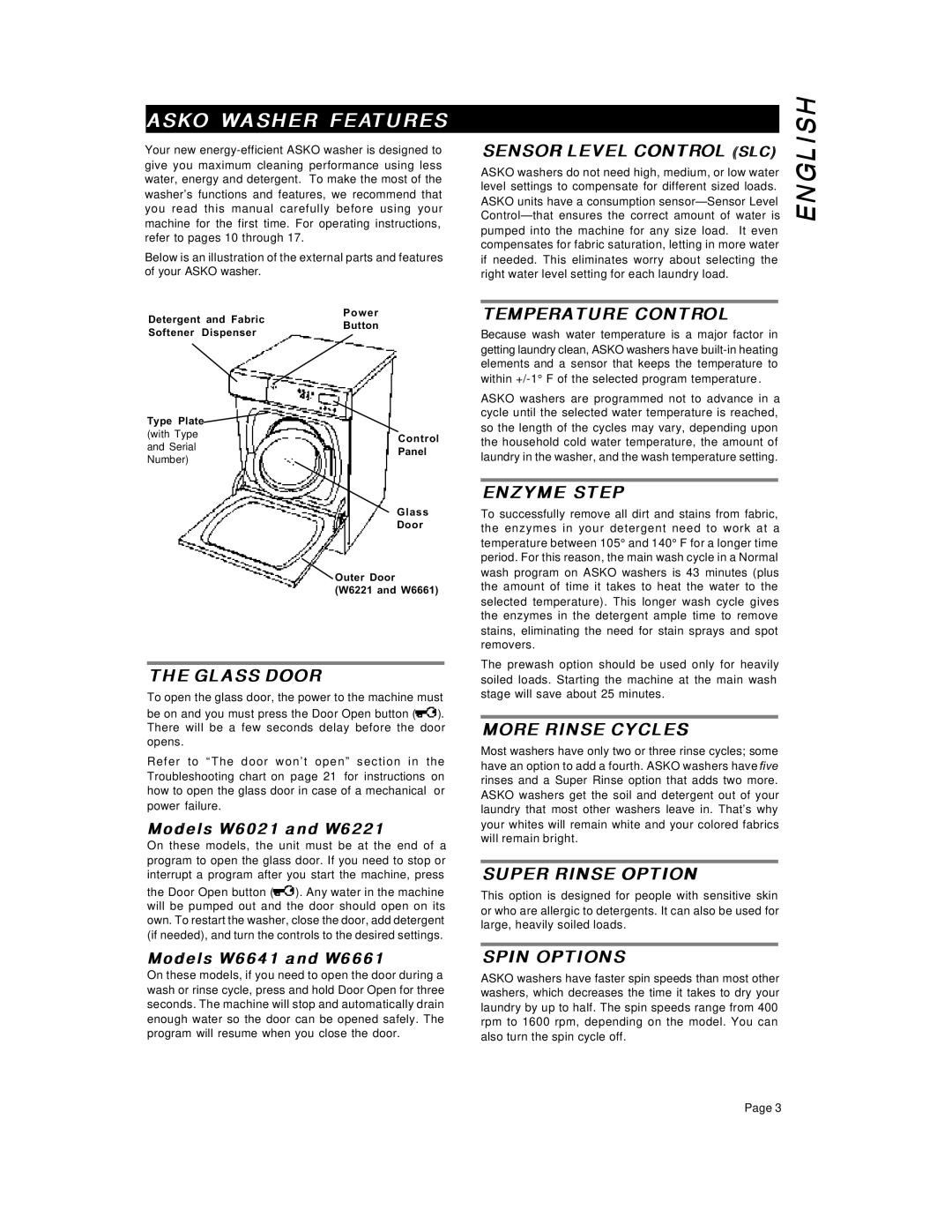
ASKO WASHER FEATURES
Your new
Below is an illustration of the external parts and features of your ASKO washer.
SENSOR LEVEL CONTROL (SLC) | ENGLISH |
ASKO washers do not need high, medium, or low water | |
level settings to compensate for different sized loads. | |
ASKO units have a consumption | |
pumped into the machine for any size load. It even |
|
compensates for fabric saturation, letting in more water |
|
if needed. This eliminates worry about selecting the |
|
right water level setting for each laundry load. |
|
Detergent and Fabric
Power
TEMPERATURE CONTROL |
Softener Dispenser
Button
Because wash water temperature is a major factor in |
getting laundry clean, ASKO washers have |
elements and a sensor that keeps the temperature to |
within |
ASKO washers are programmed not to advance in a |
cycle until the selected water temperature is reached, |
Type Plate |
| |
(with Type | Control | |
and Serial | ||
Panel | ||
Number) | ||
| ||
| Glass | |
| Door | |
| Outer Door | |
| (W6221 and W6661) |
THE GLASS DOOR
To open the glass door, the power to the machine must
be on and you must press the Door Open button (![]()
![]() ). There will be a few seconds delay before the door opens.
). There will be a few seconds delay before the door opens.
Refer to “The door won’t open” section in the Troubleshooting chart on page 21 for instructions on how to open the glass door in case of a mechanical or power failure.
Models W6021 and W6221
On these models, the unit must be at the end of a program to open the glass door. If you need to stop or interrupt a program after you start the machine, press
the Door Open button (![]()
![]() ). Any water in the machine will be pumped out and the door should open on its own. To restart the washer, close the door, add detergent (if needed), and turn the controls to the desired settings.
). Any water in the machine will be pumped out and the door should open on its own. To restart the washer, close the door, add detergent (if needed), and turn the controls to the desired settings.
Models W6641 and W6661
On these models, if you need to open the door during a wash or rinse cycle, press and hold Door Open for three seconds. The machine will stop and automatically drain enough water so the door can be opened safely. The program will resume when you close the door.
so the length of the cycles may vary, depending upon |
the household cold water temperature, the amount of |
laundry in the washer, and the wash temperature setting. |
ENZYME STEP |
To successfully remove all dirt and stains from fabric, |
the enzymes in your detergent need to work at a |
temperature between 105° and 140° F for a longer time |
period. For this reason, the main wash cycle in a Normal |
wash program on ASKO washers is 43 minutes (plus |
the amount of time it takes to heat the water to the |
selected temperature). This longer wash cycle gives |
the enzymes in the detergent ample time to remove |
stains, eliminating the need for stain sprays and spot |
removers. |
The prewash option should be used only for heavily |
soiled loads. Starting the machine at the main wash |
stage will save about 25 minutes. |
MORE RINSE CYCLES |
Most washers have only two or three rinse cycles; some |
have an option to add a fourth. ASKO washers have five |
rinses and a Super Rinse option that adds two more. |
ASKO washers get the soil and detergent out of your |
laundry that most other washers leave in. That’s why |
your whites will remain white and your colored fabrics |
will remain bright. |
SUPER RINSE OPTION |
This option is designed for people with sensitive skin |
or who are allergic to detergents. It can also be used for |
large, heavily soiled loads. |
SPIN OPTIONS |
ASKO washers have faster spin speeds than most other |
washers, which decreases the time it takes to dry your |
laundry by up to half. The spin speeds range from 400 |
rpm to 1600 rpm, depending on the model. You can |
also turn the spin cycle off. |
Page 3
